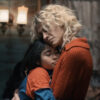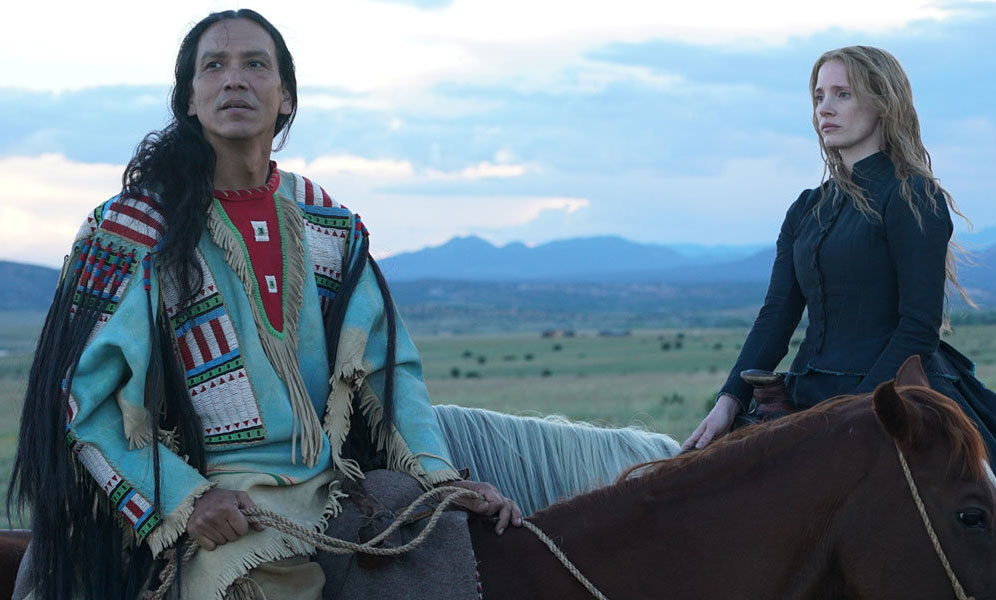The most challenging day of filming on “Woman Walks Ahead” for Susanna White didn’t involve a massive setpiece or an elaborate stunt, although both were possibilities given the story of Catherine Weldon’s epic quest to paint a portrait of Sitting Bull in the midst of the Lakota chieftain protecting land of his tribe and others from further encroachment by the U.S. government. In fact, it involved a scene of relative quiet that White had seen played out in front of her hundreds of times before – too often, as it turned out.
“That first meeting of Catherine and Sitting Bull in the potato field we ended up having to shoot that over three days,” recalls White. “I had done that scene so many different times with so many different actors, auditioning people, that when you’ve worked on a scene that much, it becomes this big obstacle in the shoot. Catherine has to come into the scene with one set of expectations, imagining this kind of noble savage in Sitting Bull, and he has to surprise her with his sophistication and his humor, and [you’ve got to] keep a scene fresh when you’ve done it a lot of times and make it feel like you’re doing it for the first time.”
Weather didn’t help the cause, as the wind kicked up one day and didn’t come back the next, requiring wind machines to be brought in for continuity’s sake, but this was nothing for White, who once presided over an eight-month shoot in Namibia, Mozambique and South Africa for the Iraq War drama “Generation Kill,” and did one better than making pigs fly in “Nanny McPhee Returns,” instead seeing them make like Esther Williams to do a synchronized swimming routine. No, she was worried that in spite of whatever sparks were flying between Jessica Chastain and Michael Greyeyes, playing Weldon and the legendary Native American leader, she needed to shake things up to make the scene come alive.
“I messed with it a bit,” says White. “I made Michael do some completely different stuff from what we had rehearsed in order to find the shape of the scene again.”
In a way that rejiggering could describe White’s approach to “Woman Walks Ahead” as a whole, honoring the Western genre that the filmmaker grew up adoring from across the Atlantic in their sense of adventure and epic sweep while offering up something fresh. With a steady hand and remarkable versatility, White would’ve fit right alongside the directors responsible for the classics of the genre at the height of the studio system era such as John Ford, Howard Hawks and William Wyler, yet makes a film that stands out in expressing perspectives long excluded from those days. Working from a script from “Eastern Promises” writer Steven Knight, the director gives voice to the Native American and female experience of the West through the friendship that forms between Weldon and Sitting Bull, who recognize in each other a similar feeling of marginalization that gives way to a renewed sense of purpose after having been exhausted by all the battles they’ve had to fight before. As the drafting of the Allotment Act (better known as the Dawes Act) that sought to divide Native Americans further by dissolving tribal governance and ownership of property in favor of individual ownership commences, the two must rally support amongst the entire Sioux nation to show their collective strength as unsympathetic government emissaries (including Sam Rockwell and Bill Camp) seek to fracture their resolve.
White’s vision is as clear-eyed as her two protagonists and she’s able to fashion “Woman Walks Ahead” into something quite impactful, even as it remains light on its toes thanks to the playful relationship that burgeons between Weldon and Sitting Bull. On the eve of the film’s release, the director spoke about how she struck that balance as well as how intense authenticity yielded a richer drama and being conscious of other dramatic treatments of this history in order to add something new to the mix.
I was sent the script and it was love at first sight – I’d actually been looking for a big love story set in an epic landscape like “The English Patient.” This film isn’t that really, but it has some of those qualities and what I responded to so strongly was that it was a forgotten piece of history, the story of this remarkable woman who so bravely set out from Brooklyn totally on her own in the 1880s to the Dakotas with the intention of painting a portrait of Sitting Bull. Then [she] became increasingly politicized and started campaigning for Native American land rights, which she was to do her whole life. But she was doing that at a time when women were really disenfranchised – before women had the vote.
What was also interesting is [“Woman Walks Ahead”] was a western told with a female gaze. There’s something about westerns that really intrigued me as I watched them when I was growing up – a very spiritual quality, certainly the westerns of John Ford in the way they’re framed, and I love them for the sense of place and this idea that people were very small in the big scheme of things – but women were not very present in them. It was a man’s world where men were men and what made this irresistible for me was that it was told through the eyes and ears of this very remarkable woman.
When telling the story of a culture that’s not your own, what responsibility does that come with as far as getting it right?
It was very important to me to educate myself as much as I could and be as inclusive as I could with people from the Lakota community. So I had as my assistant a young man named Willie White, who had done the Sundance Lab, and it wonderful driving to set with Willie because he would always put me in the right mindset. He would give me so much every morning, just small details and even just his attitude to what the weather was like. And I did feel a great weight of responsibility, but the film tells its story through the gaze of Catherine Weldon – that it’s her coming to have an understanding of the issues and of that place and of those people, so I’m not saying here’s Susanna White here telling Sitting Bull’s story, but it’s really a film about Catherine Weldon entering into that world.
It was also very, very important in making this movie that we champion what an extraordinary culture the Sioux culture was. When I started researching, I realized one of the things the white settlers did was to really try and eradicate their culture completely. The [federal] agents made it illegal for the Sioux people to wear traditional clothing to carry out ceremonies, so as well as the terrible genocide we witness on so many levels – which I have to say the British were responsible for as well, there’s an element of trying to wipe out a whole culture artistically. So we wanted to celebrate the art – how beautiful the beadwork was, how those buffalo ropes are made – and we recreated things as they were. And it wasn’t just costume design for the sake of costume design. We were actually doing something really important culturally, so we see the costume change over the course of the movie, from the start where Sitting Bull is wearing Western clothing, [which is] what he’s meant to be wearing, but gradually you see a shift across the film to more of the really beautiful Native American clothes being worn. I had such a great [costume] designer in Stephanie Collie, and Geoffrey Kirkland, who is the main designer, and celebrating just how beautiful that culture was one of the joys of making the film.
Some things, like when we had the ghost dance, that was the first time that dance had been done in over a hundred years, so it was a big responsibility to bring this very significant spiritual dance to life.
 Since a sense of place was part of the appeal of Westerns, what was it like to be out there and convey that experience onscreen?
Since a sense of place was part of the appeal of Westerns, what was it like to be out there and convey that experience onscreen?
Coming from England where everything is so small and so hemmed in and crowded, I really wanted to depict the sense of space in the American West and the spiritual quality of the land, so a much more ancient America where you feel the power of the sky. One of the first things that actually introduced me to Native American history was when I was at Sundance [one year] and I was introduced to a filmmaker who was from the Hopi reservation. He invited me to a rain dance ceremony there and I just remember this amazing music, hearing the chanting all day, and then as the sun went down, we stood on the top of the mesa and the rain clouds came in. There was rain and a double rainbow there at the end of the day.
One of the takeaways I wanted people to have from the film was to think about the environment they live in. As Sitting Bull says, this whole idea of owning the land is a strange one. He says, “Do you think you can buy the land? Do you think you can buy the sky as well?” That whole idea – I wanted to rethink the idea of property and what it means to inhabit a place. We’re custodians for a while, but the land is there before any of us, we live our span and then we’re gone and the land will be there after us. And before the arrival of the white settlers who took away their land, the Lakota people migrated with the buffalo and lived in harmony with their environment. They took just what they needed, but they didn’t take too much and I think we can learn a lot from that. We found there was a lot that was resonating at the time we were shooting it because the Dakota Pipeline protests at Standing Rock [were happening at the same time], so those issues haven’t gone away.
It’s a very playful relationship between Catherine and Sitting Bull, which seems a little bit different tonally for you when you’re known for more intense dramas. Was it exciting for you to work with?
I love humor. It’s something that I’ve loved all the work I’ve done with Tom Stoppard or David Simon and I’m someone who loves to laugh, so I think no matter what the subject matter, you can always find humor in it. But it was one of the things that really appealed to me about Steve [Knight]’s writing, mainly because we’d seen so many depictions of Sitting Bull as a noble savage – whenever I spoke to any of the Lakota people, they talked about how Sitting Bull was a really great spiritual leader for them, whereas in the West, he’s been depicted as this violent war leader. And what I loved about what Steve brought to the page was [Sitting Bull] was a very layered and well-rounded character. He had been to New York and Washington. Catherine arrives and speaks to him very slowly in this kind of pigeon English, trying to make him understand and he answers with such sophistication in their first meeting. And I love that he teases her – a playful quality is very typical of a lot of the Lakota people that I met. It’s very human, so that was something that really appealed to me about the writing.
Then what I worked on with Steve was drawing Catherine’s character out as much as possible and creating places where the film had resting points where you could just stop and think and feel the power of nature and how alive it was in a Nic Roeg “Walkabout” way where you felt how populated that landscape was by insects and by other life as well as human life.
 Did the weather cooperate? It looks like it did, but I know that’s not always the case.
Did the weather cooperate? It looks like it did, but I know that’s not always the case.
It did. We shot the movie in 31 days and for Jessica, with her beautiful porcelain skin, we were having to put a lot of silks up because the sun was very strong. It was also quite windy and the dust was kicking up, so it was a challenging environment to work in, particularly for her. But she really embraced that. She said she wanted us to feel what Catherine went through – what it would feel like to carry the weight of a trunk through the dusty landscape and she wanted to sweat and she wanted to feel the rawness of it. She’s very brave as an actress in that way. She really goes for it and I really loved that about her.
What was it like finding Michael Greyeyes to play Sitting Bull?
It was a big search. I was so lucky to get Jessica onboard and then I knew I had this big challenge to find someone who could not only hold their own against her, but do justice to this very key figure in Lakota history. I saw so many people who had done a lot of work, people who had done nothing and people who we knew of and when I met Michael, I knew there was something really special about him. He started out as a dancer and he is super smart. He teaches at York University and he’s very thoughtful, but there’s also a gentleness about him, which I thought was a really good quality for Sitting Bull, so I was so happy to find him. And there are so many others, like Chaske Spencer or Rulan Tangen, who I particularly love who plays McLaughlin’s wife. She’s a choreographer who helped with the choreography on the ghost dance, and one of my favorite scenes is when she’s translating Sitting Bull’s big speech at the commission. You see her – she’s translating the emotion of how it’s landing on her what he’s saying – and it’s another example of this story being told through a female gaze.
“Woman Walks Ahead” opens on June 29th in Los Angeles and New York at the Village East Cinemas.





